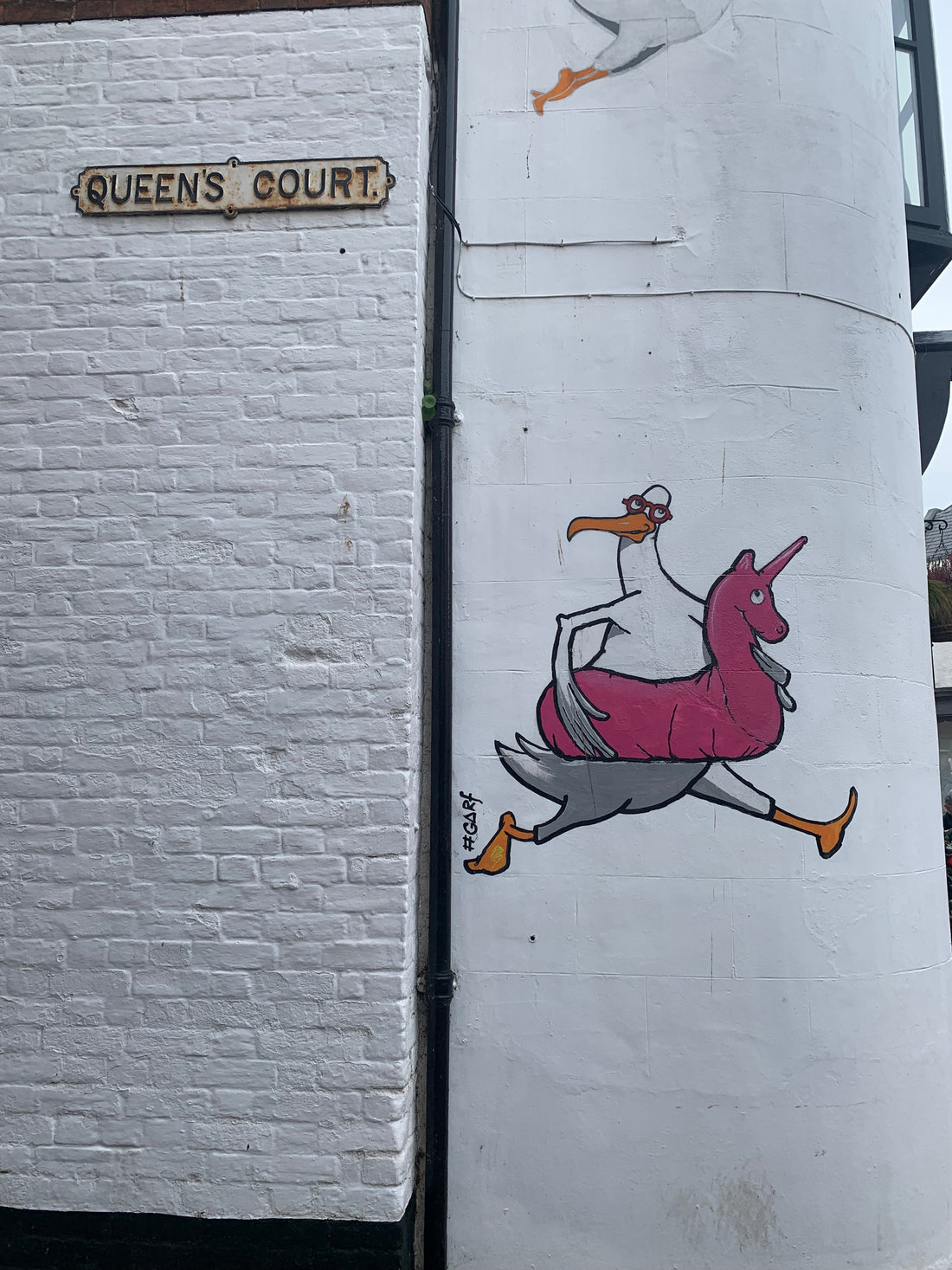As we wrap up warm in the run-up to Christmas, desperately buying those last minute gifts for our loved ones, we thought it'd be appropriate to look into instances of artists generously donating their work to the public, either through museums, exhibitions, or even street and graffiti art, which has been a fantastic way of lighting up our buildings with colour for many decades. Then we'll go back hundreds if years and have a look at how art gifting played a significant role in the customs and politics of the Italian Renaissance.
Exmouth's Banksy
We start this blog with a local treasure in Exmouth known by the name of Garf, a talented street artist. He's had a busy few years, completing 91 pieces across 51 sites, imbuing our streets with vibrant colour and beautiful design. He has also recently published a street map of his work, so you could commit a full day to exploring his wonderful artworks. He's made quite a name for himself here, taking on the moniker of Exmouth's Banksy. Below is an example of a work by Garf that is just outside our office!

An Artist Goes Undercover
Marcel Duchamp was...let's just say he was a character. He was one of the first modern day artists to gift to the public with his piece, Fountain, for an art show in 1917. He gave the piece under the name of "R. Mutt," presumably to hide his identity as the artist. He had to pay $7 to have the piece exhibited in the show, and never intended on making any money from it. This sounds incredibly generous, until you realise that the piece was simply a porcelain urinal with his fake name signed at the front. That's it. Even the gallery he sold it to didn't feign to include it in their showcase, despite having to accept it as part of the rules they were bound to. As part of his explanation for this masterpiece, he stated that it was an example of "everyday objects raised to the dignity of a work of art by the artist's act of choice." Well, whatever it was supposed to mean, thank you, it really is one of a kind...
New York's Lichtenstein Station
In 1990, the Metropolitan Transportation Authority (MTA) Arts for Transit program commissioned Roy Lichtenstein to create a mural to be placed in for the Times Square subway station at 42nd Street and Broadway as a gift to all New Yorkers. Bear in mind, by this time his works had sold It wouldn't be until 12 years later, when he had passed away, that the 6 feet high and 53 feet long artwork was installed in the station. The mural depicts a futuristic version of the Big Apple, using elements of science fiction and geometric symbols to create a unique view of his hometown. Not every city offers a look at a painting worth several million dollars on your commute to work every morning, now does it?

Art Through the Letterbox
The clatter of letters falling through your letterbox can send a nervous jolt running through you. Rent is coming up soon. Did I pay the electricity bill? The postman can be so much more than the harbinger of bad news, though. In 1950s America, if you happened to be a notable in the art world, it was possible to receive one of Ray Johnson's unique examples of mail art. Another native New Yorker, Johnson began posting correspondence accompanied by small collages, prints of abstract drawings and poems; this would eventually lead to the formation of the New York Correspondence School.
Johnson's example has been followed faithfully by several artists in the following decades. In the mid 1990s, the artist and curator Matthew Higgs set up Imprint, which posted art by young British artists, among them Martin Creed, to critics and curators. Mail art has also been thought of as the preceder of 'net art', a movement that started with the rising popularity of the internet. This type of art typically involves participation and interaction from the audience. It can be used to spread a message, either political or social, using human interactions.
Art Takes to the Streets
While this has partly been explored with our local street artist, I thought that street and graffiti art deserves its very own coverage. What is different about these types of art is the ready availability to the general public. Gone was the need to go to a dusty museum or to fork out thousands or even millions of pounds for an original piece. Now, the normal commuter could pass a famous piece on their way to work, flying by the train window or looming over you as you walk underneath a building. Art in this way is a gift to the local community that the artist works in. There are many examples of artists that promote this idea of easy accessibility to art in the UK alone(and all with funky names) such as Banksy, Stik and Inksy. This has also served to combat the monotone (and frankly quite depressing) brutalist, slate-grey buildings that crept up in our architecture during the 1950s and 1960s.
The Old Italian Way
We all know the famous speech from Juliet in the famous Shakespeare play set in Verona: “O Romeo, Romeo, wherefore art thou Romeo?”. Well, in real life Renaissance Italy, he most likely would have been buying her a shiny new piece of glassware, or maybe a commissioned portrait from one of the many artists flourishing during the period.
The culture of Renaissance Italy meant that various special occasions would warrant the exchange of gifts. Marriage and courtship would have involved much of this exchange of art as part of cementing their alliance. The elite of society especially would commission expensive tapestries, nuptial portraits, glassware down to jewellery and musical instruments in order to conform to this practice. This emanated from the concept known as 'il corteggiamento' (directly translated to 'courtship') which involved a man courting a woman with chivalrous gestures and romantic gestures. However, there was little to no freedom when it came to interaction between the betrothed, so courtship usually amounted to the display of wealth and status through gifts.
One example that survives is a painting that depicts the Old Testament encounter between Solomon and the Queen of Sheba, the latter of which traveled with a large retinue carrying a rich tribute of precious gems and spices to test the wisdom of the Israelite king. It is thought that the piece was originally used as a serving tray commissioned to commemorate a birth, a common enough practice that was happening during this time. I don't know about you, but that sounds much better than a pack of socks!
Now that we've come to the end of the blog as well as 2024, it is comforting to know that art is not an exclusive club that only the rich and famous get to admire, but is accessible to everyone. Artists like Duchamp and Johnson pioneered new forms of art that reinforced a sense of an artistic community, a baton they have since passed down to graffiti and street artists who are busy making our streets pulse with colour and creativity.

